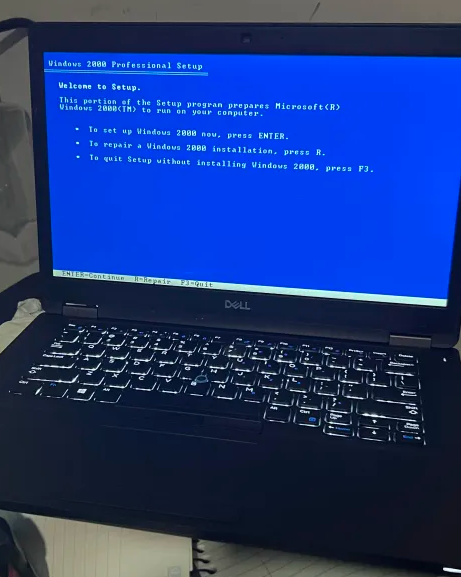GD 2W10's Achievements
35
Reputation
-

NTOSKRNL Emu_Extender for Windows XP/2003
GD 2W10 replied to Mov AX, 0xDEAD's topic in Pinned Topics regarding Windows XP
it worked -

Is it possible to boot Windows 2000 on UEFI?
GD 2W10 replied to GD 2W10's topic in Windows 2000/2003/NT4
vanilla -

Is it possible to boot Windows 2000 on UEFI?
GD 2W10 replied to GD 2W10's topic in Windows 2000/2003/NT4
https://www.youtube.com/watch?v=IbPvmulgdP8 video of me attempting to boot it in uefi with freeldr -
Thank you for your response! 1. You're completely right, Windows 10 is not NT 6.x, but the modern setup environment (including boot.wim, winpe, and setup.exe) is an evolution of the Vista-era NT 6.0 base, and has remained the same until recent builds of Windows 11. What this project really uses is the Windows PE-based setup engine, which was introduced in NT 6.0 and maintained with minor changes through NT 10.0. That said, I can see how "NT 6" is misleading, I can correct it and call it "NT 6.x installer". I see you tried to boot the ISO with the normal requirements for Windows 2000. This isn’t optimized yet for low-spec VMs or retro hardware — the project’s early-stage focus is more about experimentation and concept testing on modern machines. If you can't run the Windows 10 setup, you can most likely run the Windows 2000 setup, and the point is to provide a solution for machines that cannot run Windows NT textmode setups. 2. Excellent point on the MIT license thing. Including Microsoft binaries and pairing it with the MIT license is a contradiction — and legally problematic. This project is not meant to distribute Microsoft files, and you're right: unless it's for educational, archival, or scientific purposes (and in very narrow jurisdictions), distributing ISOs with proprietary content is not permissible. I'll remove the MIT license reference and publicly take down the binaries, and eventually publish scripts, guides, and modular code, letting users supply their own legitimate installation media, similar to XP2ESD. Also, this project is very conceptual and is in early stages of development, so obviously, there will be issues. It is not reliable at the moment. 3. This project isn’t intended to replace classic setups on period-correct hardware. Instead, it’s more of a "what if?" experimental framework. It is mainly to examine what is possible with the Windows setup and older versions of Windows NT. It’s like a bridge — not perfect, not necessary for everyone, but potentially helpful for modern experimentation, VHD deployment, archival prep, and dual-boot tinkering. I am merely testing what is possible and what is not possible. 4. You make a valid philosophical point about time investment. But I’d argue that learning, tinkering, and creating tools — even limited ones — is never wasted time. If this becomes a dead end, I’ll pivot or open-source any reusable tools. If it helps just a few people revive, mod, or preserve NT-based systems, I’d say it’s worth it. I am just doing this for fun honestly. I appreciate your review! Thanks for the advice on the licensing, I did not know that.
- 4 replies
-
- win2k
- windows2000
-
(and 3 more)
Tagged with:
-
GD 2W10 started following CSMwrap - boot CSM on UEFI only systems. , Windows 2000 on Dell Latitude 5490 , Windows 2000 NT6 installer and 1 other
-
This is Windows 2000, running natively on a Dell Latitude 5490, a Kaby Lake laptop. I installed a sysprepped install of Windows 2000 with AHCI drivers and ACPI patches with my new tool, Windows NT Legacy NT6 Installer. Special thanks to @ages2001 for the installation! NT 4.0 (hopefully) coming soon!
-
hopefully, that will be released soon. but this is more conceptual right now. https://github.com/2W10/2k_nt6installer
- 4 replies
-
- win2k
- windows2000
-
(and 3 more)
Tagged with:
-
This is a new project I am working on—Windows 2000 installation with NT6 setup. This is a prototype version of the project. Supposed to be the Windows 2000 equivalent to XP2ESD. Hopefully this will eventually make it easier to install Windows 2000 and older NT versions on modern hardware by bypassing the textmode phase. I have successfully installed this on my Dell Latitude 5490
- 4 replies
-
- win2k
- windows2000
-
(and 3 more)
Tagged with:
-

Is it possible to install Windows 2000 on a Dell Latitude 5490?
GD 2W10 replied to GD 2W10's topic in Windows 2000/2003/NT4
UPDATE: I was able to bypass the 0x07B BSOD. I used WinSetupFromUSB (which uses Grub4DOS) to emulate a floppy (by editing winsetup.lst) and put the UniATA files in there while booting from a HD with DOS 7.1 + vanilla Win2k SP4 setup installed. I pressed F5 --> Standard PC and F6. I loaded the UniATA driver. It booted and brought me to the Welcome to setup screen. BUT I cannot interact with it, so I have the keyboard issue from earlier. I only used WinNTSetupfromUSB so I could have a way to get to the hard drive (bc i have an artifical block by BIOS on internal drives) This is what my winsetup.lst looks like:- 14 replies
-
- modern hardware
- dell latitude
-
(and 3 more)
Tagged with:
-

Is it possible to install Windows 2000 on a Dell Latitude 5490?
GD 2W10 replied to GD 2W10's topic in Windows 2000/2003/NT4
I meant PNP vs text mode drivers, like txtsetup.oem and txtsetup.sif. Would the F6 thing work? Bc I might be able to get it working on the laptop, but I only have SATA and USB port because it’s Kaby Lake.- 14 replies
-
- modern hardware
- dell latitude
-
(and 3 more)
Tagged with:
-

Is it possible to install Windows 2000 on a Dell Latitude 5490?
GD 2W10 replied to GD 2W10's topic in Windows 2000/2003/NT4
I am trying this again. Is there a way to get 2k to support textmode drivers?- 14 replies
-
- modern hardware
- dell latitude
-
(and 3 more)
Tagged with:
-
From FlyGoat: I need to address this directly: the posts by Dietmar on MSFN contain completely false information. I initially tried responding to their claims in another thread (#14 (comment)), but eventually gave up. It became clear that they're simply feeding my responses to an LLM and using the AI-generated replies to spread misinformation about this project. The evidence clearly shows that CSMWrap works on UEFI Class 3 devices, including OVMF, some Alder Lake-N and Alder Lake S systems. They've chosen to ignore this evidence entirely. Regarding their claims in this post: the entire "firmware lock" theory is an AI hallucination. The Intel 64 and IA-32 Architectures Software Developer's Manual Volume 3A: System Programming Guide, Part 1 (section 11.9.2) explicitly states that switching back to real mode is always possible using a specific code sequence. The CR0.PG/PE bits remain read/write with sufficient privilege. I acknowledge this project is far from perfect and may fail on some systems. I investigate issues case by case when possible, though I don't always find solutions. This is a hobby project, and I can only dedicate limited time and resource to it. Honestly, seeing this kind of misinformation being spread about my work is really disheartening.
-
i tried this it doesnt work for me, it just hangs on the "SeaBIOS (version __________)"
-
Hi, I am trying to make this work on my Surface Pro 1. But when I put it on the UEFI partition, it boots but hangs at SeaBIOS. I tried pressing ESC and 1-2 but nothing worked. It started randomly working with freedos but it didn't load Then I replaced it with windows 7 x86 and made it the active partition and now it's hanging at this screen again (just the version name) i tried installing ms-dos on there it still hung but after a few reboots it actually said "press esc for boot menu" How do I fix this? it is on my ssd my setup: MBR disk 100MB partition with the csmwrap.efi placed in /EFI/BOOT and named as bootx64.efi and then the partition with freedos, win7 or ms-dos
-

Is there a way to boot BIOS/CSM on a UEFI Class 3 device?
GD 2W10 replied to GD 2W10's topic in Hardware Hangout
UPDATE: I got it to compile... -

Is there a way to boot BIOS/CSM on a UEFI Class 3 device?
GD 2W10 replied to GD 2W10's topic in Hardware Hangout
is there a way to fix this???




